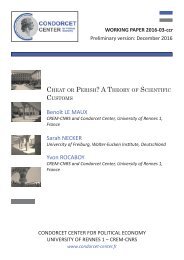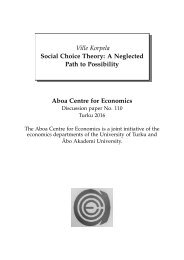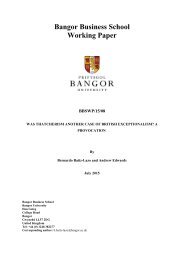MEMORANDUM
n?u=RePEc:hhs:osloec:2016_018&r=hpe
n?u=RePEc:hhs:osloec:2016_018&r=hpe
Create successful ePaper yourself
Turn your PDF publications into a flip-book with our unique Google optimized e-Paper software.
observations would be sufficiently different to allow identification. Leontief had enlisted<br />
the help of a mathematician of Kiel University, Robert Schmidt, to work on the formulae to<br />
be used in the estimation. Schmidt wrote an appendix to Leontief (1929) to set out the<br />
mathematical derivation of the key formulae and later also published a separate paper,<br />
Schmidt (1930).<br />
Leontief’s method would then supposedly determine the two structurally invariant<br />
elasticities but also the shifts of the supply and demand curves. From this information<br />
various parameters could be calculated such as the average elasticity over a certain period,<br />
etc. Leontief (1929) comprised a number of examples to demonstrate the feasibility of the<br />
method and acknowledged that the method would only work under conditions that were not<br />
always fulfilled.<br />
No other paper made Leontief’s name internationally known so widely and quickly as<br />
this paper. This was not least due to the efforts of Bernhard Harms, the publisher of<br />
Weltwirtschaftliches Archiv, in distributing offprints together with a personal letter to a<br />
large number of scholars in economics and statistics in several countries. The article itself<br />
had an initial Vorbemerkung by Bernhard Harms, as follows:<br />
“The current dissertation comprises an attempt at developing a new method for<br />
statistical market analysis. A continuation of the statistical-methodological work<br />
and the market analyses conducted by means of this method is intended. The<br />
publication of this treatise, which still has a number of open problems, is due to our<br />
wish to make the statistical method available for scientific discussion.” (Leontief<br />
1929, p.1*, transl. by ob).<br />
There is a discernible element of publisher’s pride in the programmatic announcement<br />
of a “new method” but also a guarded allusion to “a number of open problems,” perhaps a<br />
cautious admonition that had come from Leontief?<br />
After completing the 50-page article, submitting it for approval by the Institute, and<br />
undertaking the first round of proof reading it, Leontief left Kiel abruptly on a ship bound<br />
for Shanghai months before the article was published. The further proofreading was taken<br />
care of by one of his Astwik colleagues, Gerhard Meyer, who served as the relay between<br />
Leontief and the Institute during his absence.<br />
The Chinese interlude<br />
In 1929 there was thus an odd interlude in Leontief’s career as he interrupted his work<br />
at the Kiel Institute to spend most of a year in China. It is merely a parenthesis in<br />
Leontief’s scholarly career. But it was a detour he obviously appreciated, after being a<br />
hardworking student for so many years. It gave him a glimpse of the orient, and, more<br />
important, an opportunity to practice as an economic advisor in the field. Many of<br />
Leontief’s students and friends would have heard him tell about his Chinese adventure.<br />
43





